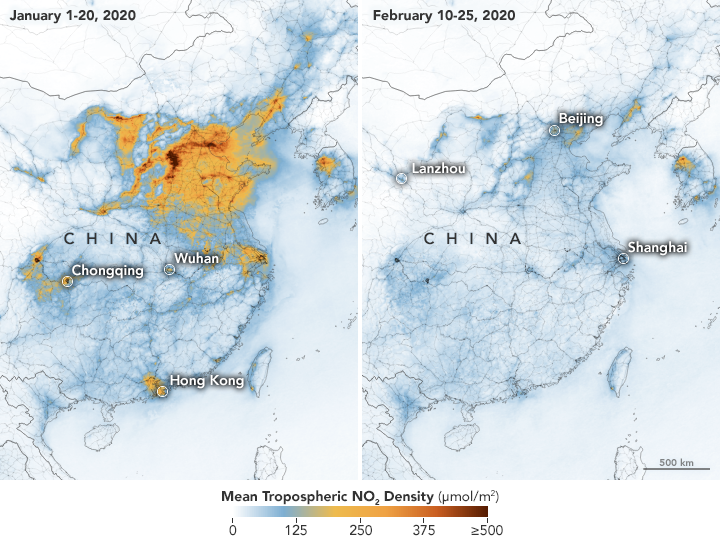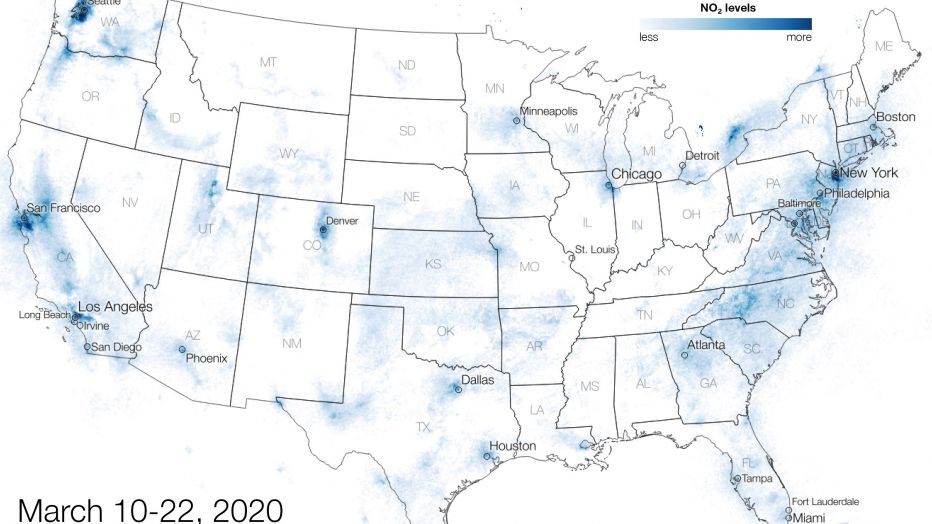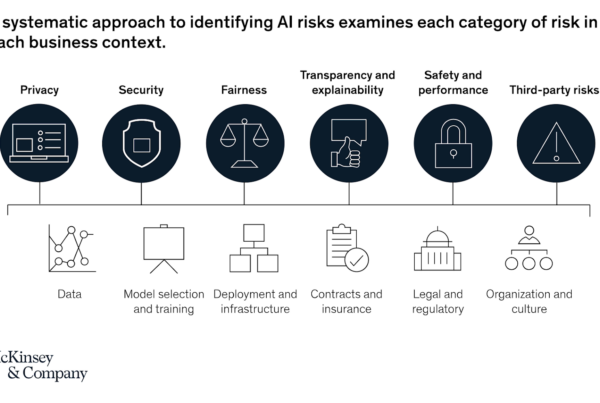Today, I was thinking about the effects of weathering a global pandemic, and how we might make a lasting change once we are on the other side of the immediate crisis. A story too large to ignore is how the economic slowdown following the outbreak of the coronavirus is facilitating a cleansing period across Earth’s biosphere. NASA and European Space Agency (ESA) pollution monitoring satellites picked up on noticeable decreases in nitrogen dioxide (NO2) over China over a time period of January 1 to February 25, 2020. Data was collected from the Tropospheric Monitoring Instrument and ESA’s Sentinel-5 satellite; a related sensor, the Ozone Monitoring Instrument (OMI) on NASA’s Aura satellite, collected similar measurements.

Visuals show a drop in pollution, comparing 2019 to 2020.
In fact, more significant NO2 reductions have been captured elsewhere, including Italy and across Europe, as well as here in the United States.

The reports of an environmental bounce-back that have come in from all corners of the globe are heartening. These findings directly correlate to a change in human behaviors and a decrease in economic-fueled activities. However, while the earth has shown us it is capable of healing, it’s going to take more than feel-good social posts to enact enduring changes. “Addressing long-term air quality problems requires ambitious policies and forward-looking investments,” Hans Bruyninckx, executive director of the European Environmental Agency, recently told CNN. “As such, the current crisis and its multiple impacts on our society work against what we are trying to achieve, which is a just and well-managed transition towards a resilient and sustainable society.”
I remember reading a blog post Bill Gates published in October 2018, about climate change and the 75% problem, exploring how every sector of the economy would need to get to zero net greenhouse gas emissions to prevent the worst effects of climate change. The five main categories, or what he calls “grand challenges” in stopping climate change, include electricity (25%), agriculture (24%), manufacturing (21%), transportation (14%), and buildings (6%).
“I think these grand challenges are a helpful way to think about climate change. They show how energy isn’t just what runs your house and your car. It’s core to nearly every part of your life: the food you eat, the clothes you wear, the home you live in, the products you use. To stop the planet from getting substantially warmer, we need breakthroughs in how we make things, grow food, and move people and goods—not just how we power our homes and cars,” wrote Gates.
Forward-thinking leaders like Gates have presented data and inspired a vision of necessary and timely change, but most of our behaviors have largely continued on unaffected by the warning signs. Even with activism around single-use plastics and carbon footprints, wide sweeping action around addressing CO2 emissions from manufacturing, transportation, and the building has not kept pace with the rate of human movement and productivity.
At the end of 2019, as we were just beginning to learn about coronavirus, global greenhouse gas emissions set an all-time high record. In a grim estimate released by the Global Carbon Project – a Global Research Project of Future Earth and a research partner of World Climate Research Programme that was formed to work with the international science community – the organization acknowledged that while the worldwide usage of fossil fuels had decreased, the total carbon emissions from human activities would hit a record 43.1 billion tons by the end of the year. “The single most important result is that we have yet another year of growth in CO2 emissions coming from all human activities,” Pep Canadell, executive director of Global Carbon Project. “I think that it is very important to acknowledge at this moment that every single additional year of emissions growth makes it significantly harder to achieve the goals of the Paris Agreement.”
The World Health Organization identifies air quality as closely linked to Earth’s climate and ecosystems, which impacts both developed and developing countries; however, it disproportionately affects low- and middle-income countries with the greatest toll in the Western Pacific and Southeast Asia regions. Cutting back on travel-related emissions from human activities like global supply chains, tourism, and business travel, means making a significant impact on reducing illnesses like stroke, heart disease, lung cancer, and chronic respiratory diseases that cause 4.2 million deaths a year.
The interconnectivity that we sought through increasing global travel, we can achieve in the interim by using more of the technology that keeps us working, collaborating, and sharing. And with isolation measures in place for the foreseeable future, we will likely continue to see more progress in air and water quality. Smart cities, a major transformation initiative for the next decade, can also help mitigate hidden health costs. This wake-up call should further catalyze leaders to implement plans for a more connected, more conscientious role in the world and its peoples’ health.
April 2020 is the 50th anniversary of Earth Day and will be celebrated with an “Earth Day Live” event, April 22-24, accessible on computers and mobile devices.











